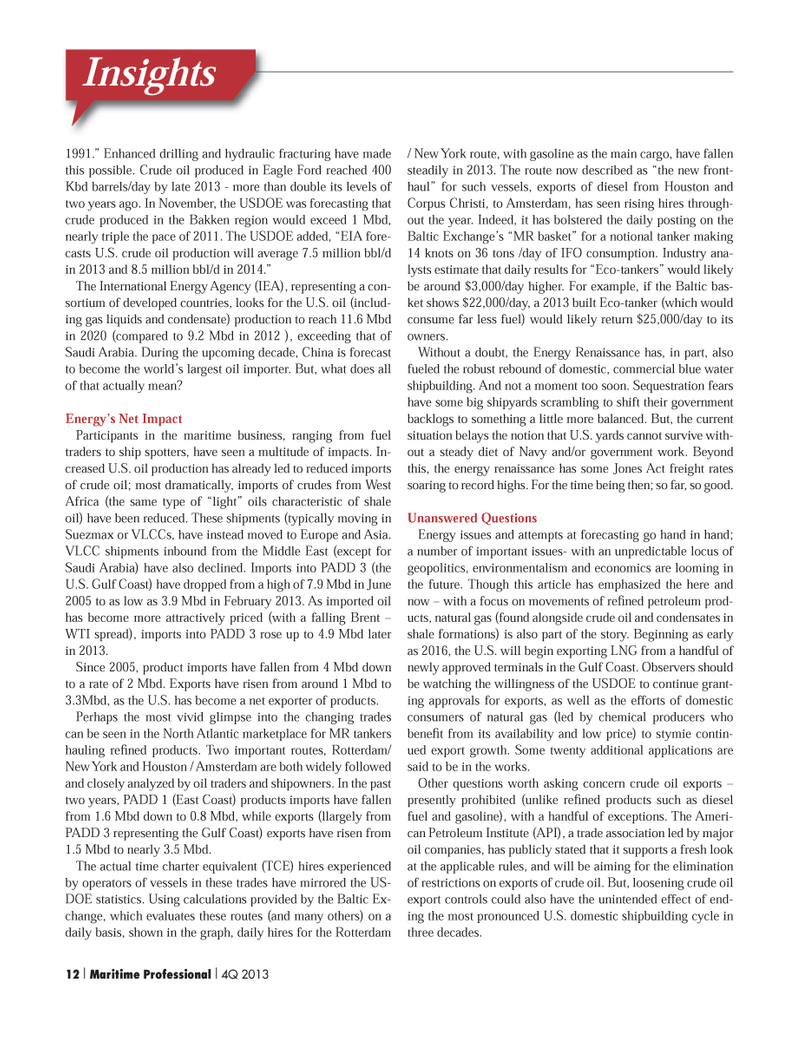
Page 12: of Maritime Logistics Professional Magazine (Q4 2013)
Shipbuilding, Repair
Read this page in Pdf, Flash or Html5 edition of Q4 2013 Maritime Logistics Professional Magazine
1991.? Enhanced drilling and hydraulic fracturing have made this possible. Crude oil produced in Eagle Ford reached 400 Kbd barrels/day by late 2013 - more than double its levels of two years ago. In November, the USDOE was forecasting that crude produced in the Bakken region would exceed 1 Mbd, nearly triple the pace of 2011. The USDOE added, ?EIA fore- casts U.S. crude oil production will average 7.5 million bbl/d in 2013 and 8.5 million bbl/d in 2014.? The International Energy Agency (IEA), representing a con- sortium of developed countries, looks for the U.S. oil (includ- ing gas liquids and condensate) production to reach 11.6 Mbd in 2020 (compared to 9.2 Mbd in 2012 ), exceeding that of Saudi Arabia. During the upcoming decade, China is forecast to become the world?s largest oil importer. But, what does all of that actually mean?Energy?s Net Impact Participants in the maritime business, ranging from fuel traders to ship spotters, hav e seen a multitude of impacts. In-creased U.S. oil production has already led to reduced imports of crude oil; most dramatically, imports of crudes from West Africa (the same type of ?light? oils characteristic of shale oil) have been reduced. These shipments (typically moving in Suezmax or VLCCs, have instead moved to Europe and Asia. VLCC shipments inbound from the Middle East (except for Saudi Arabia) have also declined. Imports into PADD 3 (the U.S. Gulf Coast) have dropped from a high of 7.9 Mbd in June 2005 to as low as 3.9 Mbd in February 2013. As imported oil has become more attractively priced (with a falling Brent ? WTI spread), imports into PADD 3 rose up to 4.9 Mbd later in 2013.Since 2005, product imports have fallen from 4 Mbd down to a rate of 2 Mbd. Exports have risen from around 1 Mbd to 3.3Mbd, as the U.S. has become a net exporter of products. Perhaps the most vivid glimpse into the changing trades can be seen in the North Atlantic marketplace for MR tankers hauling re ned products. Two important routes, Rotterdam/ New York and Houston / Amsterdam are both widely followed and closely analyzed by oil traders and shipowners. In the past two years, PADD 1 (East Coast) products imports have fallen from 1.6 Mbd down to 0.8 Mbd, while exports (llargely from PADD 3 representing the Gulf Coast) exports have risen from 1.5 Mbd to nearly 3.5 Mbd. The actual time charter equivalent (TCE) hires experienced by operators of vessels in these trades have mirrored the US- DOE statistics. Using calculations provided by the Baltic Ex- change, which evaluates these routes (and many others) on a daily basis, shown in the graph, daily hires for the Rotterdam / New York route, with gasoline as the main cargo, have fallen steadily in 2013. The route now described as ?the new front- haul? for such vessels, exports of diesel from Houston and Corpus Christi, to Amsterdam, has seen rising hires through- out the year. Indeed, it has bolstered the daily posting on the Baltic Exchange?s ?MR basket? for a notional tanker making 14 knots on 36 tons /day of IFO consumption. Industry ana-lysts estimate that daily results for ?Eco-tankers? would likely be around $3,000/day higher. For example, if the Baltic bas- ket shows $22,000/day, a 2013 built Eco-tanker (which would consume far less fuel) would likely return $25,000/day to its owners. Without a doubt, the Energy Renaissance has, in part, also fueled the robust rebound of domestic, commercial blue water shipbuilding. And not a moment too soon. Sequestration fears have some big shipyards scrambling to shift their government backlogs to something a little more balanced. But, the current situation belays the notion that U.S. yards cannot survive with- out a steady diet of Navy and/or government work. Beyond this, the energy renaissance has some Jones Act freight rates soaring to record highs. For the time being then; so far, so good. Unanswered Questions Energy issues and attempts at forecasting go hand in hand; a number of important issues- with an unpredictable locus of geopolitics, environmentalism and economics are looming in the future. Though this article has emphasized the here and now ? with a focus on movements of re ned petroleum prod- ucts, natural gas (found alongside crude oil and condensates in shale formations) is also part of the story. Beginning as early as 2016, the U.S. will begin exporting LNG from a handful of newly approved terminals in the Gulf Coast. Observers should be watching the willingness of the USDOE to continue grant- ing approvals for exports, as well as the efforts of domestic consumers of natural gas (led by chemical producers who bene t from its availability and low price) to stymie contin- ued export growth. Some twenty additional applications are said to be in the works. Other questions worth asking concern crude oil exports ? presently prohibited (unlike re ned products such as diesel fuel and gasoline), with a handful of exceptions. The Ameri- can Petroleum Institute (API), a trade association led by major oil companies, has publicly stated that it supports a fresh look at the applicable rules, and will be aiming for the elimination of restrictions on exports of crude oil. But, loosening crude oil export controls could also have the unintended effect of end- ing the most pronounced U.S. domestic shipbuilding cycle in three decades.Insights12 I Maritime Professional I 4Q 2013MP #4 1-17.indd 12MP #4 1-17.indd 1212/11/2013 4:43:17 PM12/11/2013 4:43:17 PM

 11
11

 13
13
